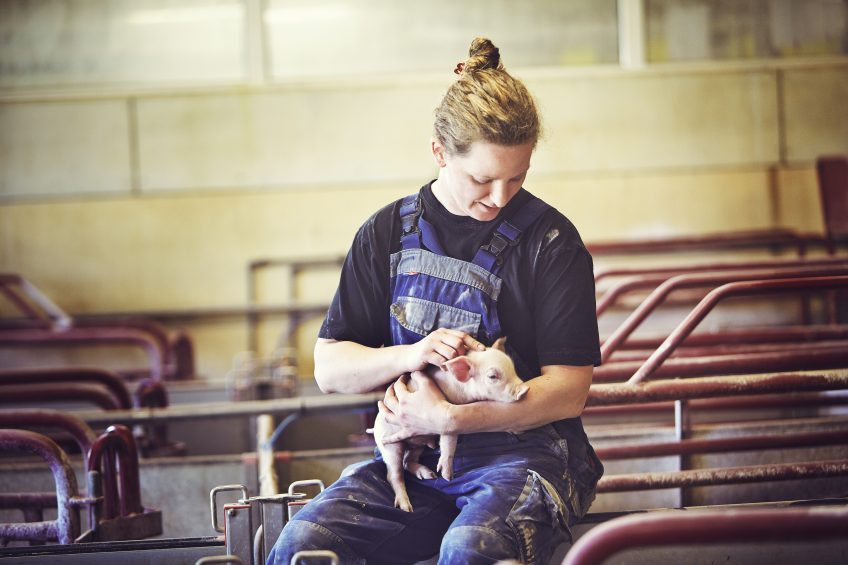8 Danish tips to help reduce antibiotics

Danish pig producers are among the highest performing in Europe and have been achieving consistent health and performance in piglets with low levels of antibiotic use for many years. The country’s expert nutritionists share 8 key tips for feeding piglets in the early stages of growth.
This article identifies various methods to help reduce antibiotics. The first five revolve around getting the started diet right. The consecutive tips apply to getting it right on-farm.
 Aim for 20% protein
Aim for 20% protein
A maximum of 20% protein in the starter diets is optimal. It is possible to go lower, but often it will limit productivity because it can be difficult to reach the recommended amino acid profile. High protein diets are closely related to the risk of diarrhoea. A smooth transition from sow milk to solid feed is essential in order to achieve a high productivity in the nursery. Due to that it is recommended to keep the protein levels in mind.
 Drive feed intake
Drive feed intake
High feed intake from the start is essential for the development of a healthy gut. To achieve this, it is good to use only the best quality ingredients possible. Starvation the first days after weaning is a well-known problem which often leads to severe diarrhoea incidences due to the damages of the intestinal wall. It is essential to look for protein sources high in digestible protein and low in anti-nutritional factors, and then to pay attention to the attractiveness and palatability of the feed. A high content of milk-derived products is a must.
 Avoid standard soybean meal
Avoid standard soybean meal
Using standard soybean meal in the starter diet should be avoided for the first 14 days as this contains anti-nutritional factors. Instead, a healthy protein source should be considered (like e.g. AlphaSoy, Agrokorn); soybean meal should be introduced gradually after this time. The intestinal tract is extremely sensitive to protein sources with low digestibility like soybean meal. Undigested protein will work as a nutrient for pathogens and reduce growth due to bad intestinal health.
 Know the milk
Know the milk
There is a huge difference between the various ‘milk’ products available today – some contain good quality skimmed milk powder, others may contain de-lactosed whey or even vegetable proteins. For the best performance, it is advised to choose a highly palatable milk product and adjust the lactose content in the feed to the age of the piglets. The digestibility of the components in the milk replacers should be carefully considered. DanMilk (also a brand of Agrokorn) offers a wide range of highly palatable milk products.
 Feed pure organic acids
Feed pure organic acids
Danish research shows that organic acids are one of the most important additives in the weaning period. It is a very suitable way to reduce E. coli, Salmonella etc. which is the common reason for diarrhoea. Trials show increased gain when adding organic acids to the feed. Pure organic acids should be used at a minimum inclusion level of 0.5% but preferable up to 1% (10 kg per tonne of feed). Organic acids should be included in the drinking water at 0.2% inclusion (2 litres per 1,000 litre water). It is vital to only use the best acids and tailor the product to optimise the feeding process.
 Start training piglets early
Start training piglets early
Piglets in this key growth stage need to learn how to eat solids, support this transition by offering liquid feed supplements or small amounts of dry feed while the piglets are with the sow. Feeding the piglets should start at the age of ten to 14 days or even earlier. It is recommended to start out with very small amounts and preferably five to eight feedings per day. Practical experiences show that feedings with small intervals drives high feed intake.
 Make gradual feed changes
Make gradual feed changes
When switching to a new feed or from liquid to dry, the process should be spread out over three to five days. It is of high importance to ensure a smooth transition without a drop in feed intake. The changes in flavour in two following diets are reduced by making a smooth transition.
 Focus on good management practices
Focus on good management practices
Management, animal hygiene and a piglet’s environment are just as important as the feed. One of the most neglected areas is the environmental conditions in the nursery. Key here is to pay attention to cleaning and disinfection of the weaner sections. Drying out the sections is crucial for limiting bacterial growth and to enhance general health of the pigs. In addition, it is pivotal never to insert newly weaned pigs into a cold and wet pen. Wet surfaces feel at least 5ºC colder than dry surfaces do. In cold conditions the pigs use energy to maintain the body temperature instead of growth. Therefore, it is essential to know what works well – and to aim towards that.











